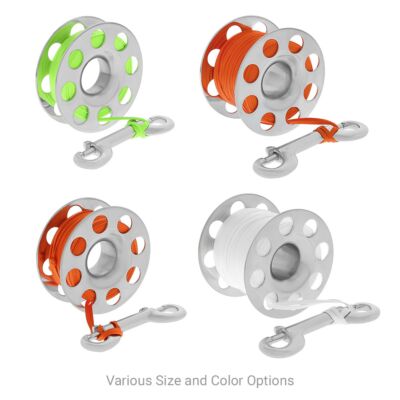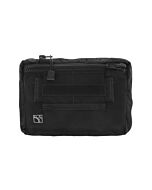DGX Custom - DGX Gears Stainless Steel Finger Spools
- Quality stainless steel material with smooth edges
- Choose from 4 different widths for your specific needs
- Loaded with custom choice of any of our engineered lines
- Includes premium 316-series stainless steel double-eye bolt snap
- All spools have {3.0 in | 7.5 cm} diameter with {1.0 in | 2.5 cm} center hole
DGX Custom - DGX Gears Stainless Steel Finger Spools
Line length is approximate.
Forming finger spools from stainless steel offers durability, of course, but also allows greater freedom in design that yields the most compact form factor possible for a given amount of line. Stainless almost doubles the capacity with a thinner profile and more perimeter holes closer to the edge. Both plastic and stainless are low weight but the typical plastic spool is almost too light and the stainless has a better feel in your hand.
These premium quality Stainless Steel Finger Spools are available in your choice of four different widths. All these stainless spools are {3.0 in | 7.5 cm} in diameter with a {1.0 in | 2.5 cm} center hole and made from a 16 gauge 304L stainless steel, TIG welded, polished and passivated for a long corrosion free life. Note that these premium stainless steel spools have smooth rounded finger holes that won't snag/cut fingers or gloves during deployment. Also, choose from three sizes of premium quality heavy duty 316-series stainless steel double eye bolt snaps: Large (the most popular, easiest to use), Small (offers minimal 'dangle'), Medium (a good compromise).
DGX CUSTOM – STAINLESS STEEL FINGER SPOOL CAPACITIES AND DIMENSIONS |
|||||||
| Size | Flat Line | Hi-Viz Line | Ultra-Viz Line™ | PES Line | Width† | ||
| Small | 80 ft | 24 m | 40 ft | 12 m | 40 ft | 12 m | 40 ft | 12 m | 0.9 in | 23 mm | ||
| Medium | 125 ft | 38 m | 65 ft | 20 m | 65 ft | 20 m | 65 ft | 20 m | 1.0 in | 25 mm | ||
| Large | 175 ft | 53 m | 85 ft | 26 m | 85 ft | 26 m | 85 ft | 26 m | 1.6 in | 41 mm | ||
| X-Large | 250 ft | 76 m | 125 ft | 38m | 125 ft | 38 m | 125 ft | 38 m | 2.2 in | 56 mm | ||
| † All are { 3.0 in | 7.5 cm } in diameter, with { 1.0 in | 2.5 cm} center hole. All dimensions are approximate. |
|||||||
| Brand | DGX Gears |
|---|---|
| SKU | PK-902500 |
| Weight | 0.600000 |
Customer Reviews
Characteristics of Line on Dive Reels and Finger Spools
Traditionally, the line on dive reels is a braided thermoplastic fiber made from polyamide (aka Nylon and PA) or more recently polyester terephthalate (aka Dacron and PET) ; each have their pros and cons. Both are strong, but nylon has significantly more elasticity while polyester has very little stretch. In water, nylon tends to become a little 'soggy' and swell slightly thus losing about 15% of its strength, while polyester retains 100% of its strength remaining 'crisp' and resilient when wet. Polyester has better resistance to abrasion and oil products, plus it is significantly more resistant to degrading from UV exposure. Polyester also noticeably better absorbs and retains the high-visibility color dyes (Orange or Chartreuse, Which is Better?). Many divers prefer polyester line claiming it deploys 'smoother' from the reel and is noticeably stronger; other divers still prefer nylon claiming its elasticity makes it easier to handle and 'tie off' in guideline applications. A few dive equipment manufacturers have been experimenting with high performance thermoplastics such as polyethersulfone (PES) and ultra-high-molecular-weight polyethylene (UHMWPE). These newer materials are many times the strength of polyester.
| Material Trade name |
Polyethersulfone Ultrason |
UHMWPE Dyneema |
Polyester Dacron |
Polyamide Nylon |
|---|---|---|---|---|
| Dry Tenacity (cN/dtex)
|
28 - 38
|
28 - 38
|
7 - 8
|
6 - 7
|
| Elongation at break (%)
|
28
|
3.5
|
10 - 16
|
16 - 27
|
| Specific gravity (g/cm
3)
|
1.37
|
0.98
|
1.38
|
1.15
|
| Melting point (°C)
|
227
|
149
|
260
|
220
|
| Abrasion resistance
|
excellent
|
very good
|
excellent
|
very good
|
| UV resistance
|
poor
|
very good
|
excellent
|
good
|
| Salt resistance
|
excellent
|
excellent
|
good
|
good
|
| Resistance to oil products
|
excellent
|
excellent
|
excellent
|
good
|
| Knot strength (%)
|
55 - 60
|
35 - 50
|
55 - 60
|
60 - 65
|
The size code numbers that describe the diameters of nylon guideline used in cave diving are from an archaic nomenclature for what is termed "twine" (braided string) and each # code describes an approximate thickness range in fractions of an inch. There does not appear to be an established standard (if you know of one, please tell us); size charts vary depending on the cordage manufacturers who each publish their own version for their products. There are four sizes normally seen on guideline reels: #36 and #24 are most common for nylon with #21 and #18 most common for polyester because it is stronger. The thinner the line the more length that can be fit on a given size reel or conversely the smaller the size of the reel for a given length. However, #18 is approaching the minimum diameter practical for manageable line handling in diving applications.









